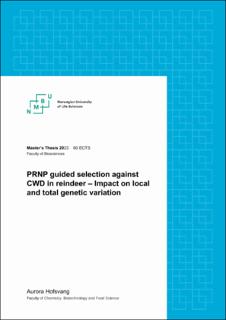| dc.description.abstract | The emergence of Chronic Wasting Disease (CWD) in Norway poses a significant threat to the populations of free-ranging and semi-domesticated reindeer. Controlling the spread of the disease is of utmost importance, and studies have indicated that different PRNP genotypes give varying levels of sensitivity to CWD in reindeer. Some genotypes offer more protection against the disease, making it desirable for reindeer herders to breed selectively to increase the ratio of CWD resistant genotypes in the populations. In all artificial selection it is important to avoid reducing the genetic variation in the population. To this end it is important to know to what extent genetic variation in the population is associated with the PRNP-genotypes.
DNA samples from reindeer were sequenced with Illumina sequencing, followed by alignment and variant calling to generate a set of SNP genetic markers for population structure and variation analysis. Analysis of population structure revealed that individuals with identical PRNP genotypes did not exhibit increased relatedness to each other compared to the rest of the individuals. However, analysis of positions surrounding the PRNP gene indicated that the PRNP genotypes influenced the variation found in the surrounding regions, suggesting the presence of linkage disequilibrium (LD) tied to PRNP alleles. Notably, the A allele, which causes sensitivity to CWD in reindeer, showed less signs of LD compared to the other alleles. This implies that the A allele has less association with specific variants than the other genotypes and could indicate a smaller chance of removing alleles from the population when selecting away from the A allele. However, importantly, as the A allele exhibited the most variation in the regions surrounding the PRNP gene, selectively removing A alleles would reduce the genetic variation in this area. As a high portion of the variants in the positions surrounding the PRNP gene is found together with the A allele this could potentially lead to the loss of additional alleles. As LD was investigated by visually inspecting clustering in MDS plots in this study more specific analysis is needed to conclude the impact of selective breeding against CWD on genetic variation in the area surrounding the PRNP gene.
In addition, this pilot study uncovered an important discrepancy. The genotypes identified through PCA amplification and Sanger sequencing differed from those identified through whole-genome Illumina sequencing for nine of the animals. Further investigation is necessary to determine the causes of these inconsistencies. | |
